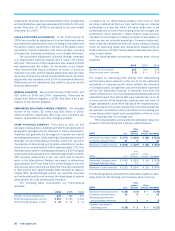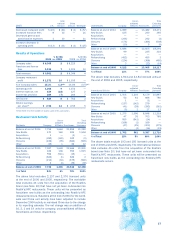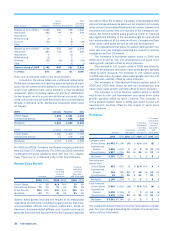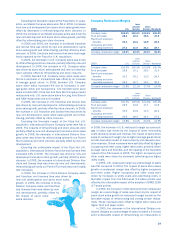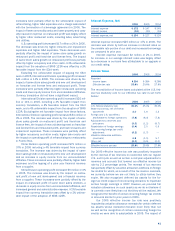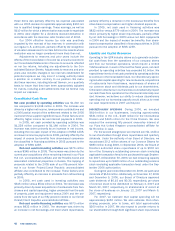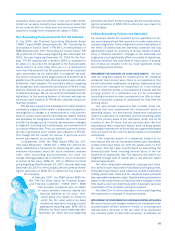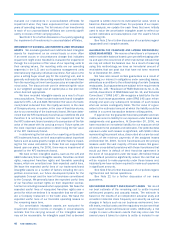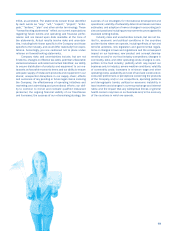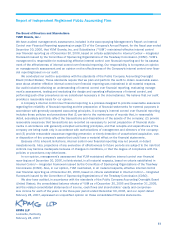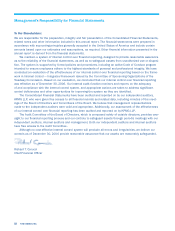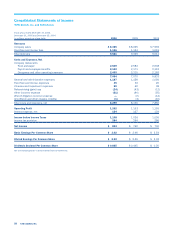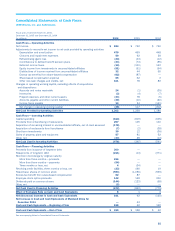Pizza Hut 2006 Annual Report Download - page 40
Download and view the complete annual report
Please find page 40 of the 2006 Pizza Hut annual report below. You can navigate through the pages in the report by either clicking on the pages listed below, or by using the keyword search tool below to find specific information within the annual report.
45
company’s fiscal year end effective in the year ended 2008.
Certain of our plans currently have measurement dates that
do not coincide with our fiscal year end and thus we will be
required to change their measurement dates in 2008.
New Accounting Pronouncements Not Yet Adopted
In July 2006, the Financial Accounting Standards Board
(“FASB”) issued FASB Interpretation No. 48, “Accounting for
Uncertainty in Income Taxes” (“FIN 48”), an interpretation of
FASB Statement No. 109, “Accounting for Income Taxes.” FIN
48 is effective for fiscal years beginning after December 15,
2006, the year beginning December 31, 2006 for the Com-
pany. FIN 48 requires that a position taken or expected to
be taken in a tax return be recognized in the financial state-
ments when it is more likely than not (i.e., a likelihood of
more than fifty percent) that the position would be sustained
upon examination by tax authorities. A recognized tax posi-
tion is then measured at the largest amount of benefit that is
greater than fifty percent likely of being realized upon ultimate
settlement. Upon adoption, the cumulative effect of applying
the recognition and measurement provisions of FIN 48, if any,
shall be reflected as an adjustment to the opening balance
of retained earnings. We do not currently anticipate that the
adjustment to the opening balance of retained earnings we
will record upon adoption of FIN 48 will materially impact our
financial condition.
FIN 48 also requires that subsequent to initial adoption
a change in judgment that results in subsequent recognition,
derecognition or change in a measurement of a tax position
taken in a prior annual period (including any related interest
and penalties) be recognized as a discrete item in the period
in which the change occurs. Currently, we record such changes
in judgment, including audit settlements, as a component of
our annual effective rate. Thus, our reported quarterly income
tax rate may become more volatile upon adoption of FIN 48.
This change will not impact the manner in which we record
income tax expense on an annual basis.
In September 2006, the FASB issued SFAS No. 157,
“Fair Value Measures” (“SFAS 157”). SFAS 157 defines fair
value, establishes a framework for measuring fair value and
enhances disclosures about fair value measures required
under other accounting pronouncements, but does not
change existing guidance as to whether or not an instrument
is carried at fair value. SFAS No. 157 is effective for fiscal
years beginning after November 15, 2007, the year beginning
December 30, 2007 for the Company. We are currently review-
ing the provisions of SFAS 157 to determine any impact for
the Company.
In February 2007, the FASB issued SFAS No.
159 “The Fair Value Option for Financial Assets
and Financial Liabilities” (“SFAS 159”). SFAS
159 provides companies with an option
to report selected financial assets and
financial liabilities at fair value. Unre-
alized gains and losses on items for
which the fair value option has been
elected are reported in earnings at each
subsequent reporting date. SFAS 159 is
effective for fiscal years beginning after
November 15, 2007, the year beginning
December 30, 2007 for the Company. We are currently review-
ing the provisions of SFAS 159 to determine any impact for
the Company.
Critical Accounting Policies and Estimates
Our reported results are impacted by the application of cer-
tain accounting policies that require us to make subjective or
complex judgments. These judgments involve estimations of
the effect of matters that are inherently uncertain and may
significantly impact our quarterly or annual results of opera-
tions or financial condition. Changes in the estimates and
judgments could significantly affect our results of operations,
financial condition and cash flows in future years. A descrip-
tion of what we consider to be our most significant critical
accounting policies follows.
IMPAIRMENT OR DISPOSAL OF LONG-LIVED ASSETS We eval-
uate our long-lived assets for impairment at the individual
restaurant level except when there is an expectation that
we will refranchise restaurants as a group. Restaurants held
and used are evaluated for impairment on a semi-annual
basis or whenever events or circumstances indicate that the
carrying amount of a restaurant may not be recoverable
(including a decision to close a restaurant or an offer to refran-
chise a restaurant or group of restaurants for less than the
carrying value).
Our semi-annual impairment test includes those res-
taurants that have experienced two consecutive years of
operating losses. Our semi-annual impairment evaluations
require an estimation of cash flows over the remaining useful
life of the primary asset of the restaurant, which can be for
a period of over 20 years, and any terminal value. We limit
assumptions about important factors such as sales growth
and margin improvement to those that are supportable based
upon our plans for the unit and actual results at comparable
restaurants.
If the long-lived assets of a restaurant subject to our
semi-annual test are not recoverable based upon forecasted,
undiscounted cash flows, we write the assets down to their
fair value. This fair value is determined by discounting the
forecasted cash flows, including terminal value, of the res-
taurant at an appropriate rate. The discount rate used is our
weighted average cost of capital plus a risk premium where
deemed appropriate.
We often refranchise restaurants in groups and, there-
fore, perform such impairment evaluations at the group level.
Forecasted cash flows in such instances consist of estimated
holding period cash flows and the expected sales proceeds
less applicable transaction costs. Expected sales proceeds are
based on the most relevant of historical sales multiples or bids
from buyers, and have historically been reasonably accurate
estimations of the proceeds ultimately received.
See Note 2 for a further discussion of our policy regarding
the impairment or disposal of long-lived assets.
IMPAIRMENT OF INVESTMENTS IN UNCONSOLIDATED AFFILIATES
We record impairment charges related to an investment in an
unconsolidated affiliate whenever events or circumstances
indicate that a decrease in the fair value of an investment
has occurred which is other than temporary. In addition, we



